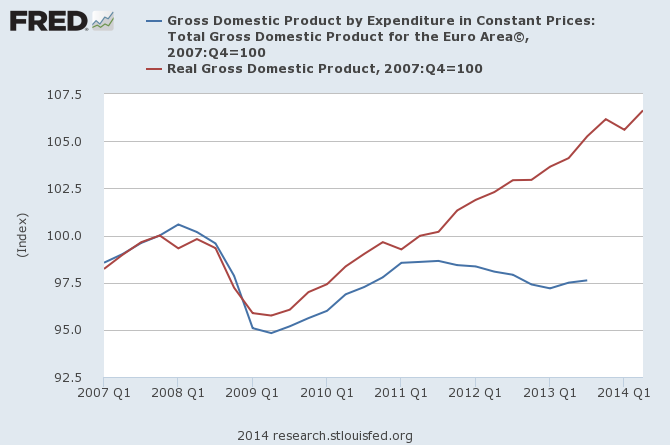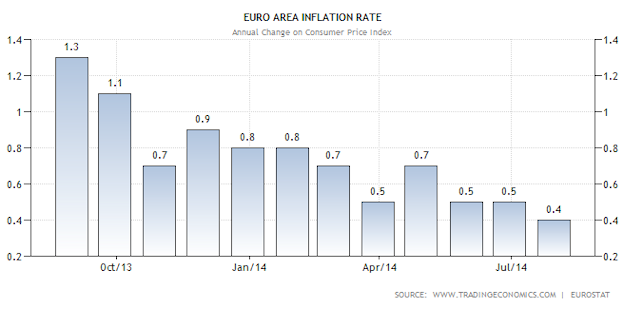Three Interesting Articles I Read Last Week by Gary D. Halbert
FORECASTS TRENDS E-LETTER
by Gary D. Halbert
August 19, 2014
IN THIS ISSUE:
1. Larry Kudlow – How to Make the Economy Better Fast
2. John Aziz – Europe is Headed For an Epic Depression
3. Doyle McManus – Obama Tests the Bounds of a Lame Duck
Overview
I’m taking most of this week off to hang out with the kids before they head back to college this weekend. So today we’ll look at a few of the most interesting articles I’ve read over the last week. I hope you enjoy them. I have some comments of my own at the end of each article.
We will start with an article on Saturday from Larry Kudlow, a CNBC senior contributor and host of The Larry Kudlow Show on radio. Larry is one of my favorite economic and financial writers because he knows how to cut right to the chase and pulls no punches. In the following article, Larry offers his no-nonsense plan to get the economy back on track – and I fully agree with him.
Secular Stagnation Is a Cover-Up
by Larry Kudlow, August 16
RealClearPolitics.com
John F. Kennedy campaigned for president in 1960 by belittling Dwight Eisenhower’s three recessions and declaring, “We can do bettah.” He was right. In the 1960s, after the Kennedy tax cuts were implemented, prosperity returned, the economy grew by almost 4 percent annually, unemployment sank to record lows and a gold-linked dollar held down inflation.
But today many leading economists are throwing up their arms in frustration and assuring us that 2 percent growth is really the best we can do.
Barack Obama’s former chief economist Larry Summers began this chant of “secular stagnation.” It’s a pessimistic message, and it’s now being echoed by Federal Reserve vice chair, Stanley Fischer. He agrees with Summers that slow growth in “labor supply, capital investment, and productivity” is the new normal that’s “holding down growth.” Summers also believes that negative real interest rates aren’t negative enough. If Fisher and Fed chair Janet Yellen agree, central bank policy rates will never normalize in our lifetime.
Unfortunately, Americans seem to be buying into this dreary assessment. A new Wall Street Journal poll finds that three out of four Americans think the next generation will be worse off than this generation. So long, American Dream.
But secular stagnation is all wrong. It’s a cover up for mistaken economic policies that began in the Bush years and intensified during the Obama administration.
It would be hard to conceive of a worse set of policy prescriptions than the ones Larry Summers and his Keynesian collaborators have conjured up. We’ve had bailouts, massive spending-stimulus plans, tax increases on “the rich,” Obamacare, rudderless monetary policy that has collapsed the dollar, the Dodd-Frank bill, anti-carbon policies, a vast expansion of the welfare state, and on and on.
These measures have flat-lined the economy. It’s as simple as that. There has been no divine intervention, with God ordaining: Thou shalt only grow at 2 percent!
The blame falls on the White House and the Fed, and the discredited Keynesian model that government spending, debt, and cheap money are the way to restore growth. Ideas have consequences, and bad ideas have bad consequences.
We’re still waiting for the government-spending multipliers and the Fed’s escape-velocity rebound to kick in.
Amazingly, the architects of this colossal policy failure are the same people who promised they would rebuild the U.S. economy “for the long term,” as Barack Obama put it in 2009. But they’re now blaming the stagnant economy on structural problems beyond their control. Oh, we get it. Consumers and businesses are wrong because they didn’t adhere to Keynesian economic models.
We have paid people not to work by raising eligibility and time limits for various benefit plans, substantially raised marginal tax penalties when people move from welfare to work, disincentivized employers from hiring more workers (Obamacare, minimum wage), raised taxes on investment, passed new regulations to strangle our energy industry, unionized even when workers don’t want it, continued corporate-welfare cronyism and refused to fix a corporate tax system that sends jobs abroad. And then we wonder why the economy won’t shift into a higher gear.
And sadly enough, this is all happening when the potential for growth, productivity, and wealth are at an all-time high.
First, thanks to the underperformance of this recovery, we are $2 trillion and nearly 10 million workers below potential output and employment. We could recapture this almost immediately with the right policies.
Second, the digital age and technological revolution have made hyper-growth more, not less, achievable. Just consider how Uber has led to amazing price reductions and efficiency improvements in the taxi-cab industry. Or think of how smart phones, robotics, disease-killing advances in biotech, and new oil and gas drilling technologies are expanding our output and wealth. Because of this private-sector productivity revolution, we can produce far more in a day than our ancestors could in a month. And it’s only just starting.
We learned in the 1960s and 1980s how fast the economy can get back on its feet when policy mistakes are reversed. That’s the real case for optimism. Imagine for a moment that we abolished the corporate income-tax rate, slashing it from 35 percent to zero. The positive results would be near instant. In a matter of weeks, a tidal wave of capital and businesses would flow across our borders and deep into the United States. [Emphasis mine.]
The secular-stagnation argument is just an excuse for liberal policy failures. Keynesianism should now be recognized as snake oil. And Republicans should recognize they now have a big opening to convince America that “We can do bettah.” END QUOTE
America has the highest corporate income tax rate in the developed world. Not only do companies have to pay 35% of all profits made in the US, but also on any profits they make overseas. No wonder that US corporations are moving their headquarters out of the US and into more tax-friendly countries like Ireland – a process known as “tax inversion.” Eliminating or greatly reducing the US corporate tax would stop this trend virtually overnight.
I haven’t written much about Europe in a while. The EU economy overall was flat in the 2Q, and several major countries are in recession. As the next article points out in detail, there are fears that the EU may be headed in the direction of Japan and its decade-long deflation. If so, that is bad news for the US and the global economy.
Europe is in an Epic Depression — and it’s Getting Worse
Why is the European Central Bank ignoring its mandate?
by John Aziz | August 15, 2014
TheWeek.com
Economic growth in Europe came in at zeroin the second quarter of 2014. That’s better than being in recession. But it’s not the growth that Europe — with its huge unemployment rate of 12 percent, or roughly 19,130,000 people out of work — needs.
The euro zone (below in blue) has been in a depression since the financial crisis. That’s because in terms of gross domestic product, the euro zone has not risen back to its pre-financial-crisis levels. The U.S. (below in red), on the other hand, has gotten out of its slump and continues to grow at a decent clip:
(Federal Reserve Bank of St. Louis/OECD)
With industrial production stagnant, mass unemployment still a problem, and inflation on a downward trend, economists such as The New York Times’s Paul Krugman worry that Europe is turning into Japan. The former second-largest economy in the world has spent more than 20 years in a deflationary depression, a spiral of falling prices which encourage people to sit on cash, causing prices to plunge even further. Europe — with its aging population — has similar demographics to Japan, too, worsening the likelihood that it might end up in the same trap.
That might be bad, but it’s still a lot better than total collapse — which is what was widely feared in 2011 and 2012 when government interest rates rose drastically in countries like Italy, Spain, Greece, Ireland, and Portugal over fears about the sustainability of their sovereign debts. Under the euro, countries don’t control their currencies, so they run a real risk of running out of money. The architects of the euro system, such as Romano Prodi, knew that this would be a problem but decided that they would cross that bridge when they came to it.
Since then, the European Central Bank (ECB) and the European Financial Stability Fund (EFSF) have been able to deploy various tools, including so-called outright monetary transactions, to backstop those governments and contain the sovereign debt crisis. Interest rates — even for countries like Spain, which two or three years ago looked in serious danger of default — are now as low as they are in the United States. Perhaps this episode illustrates that the euro was an incompetently designed currency, but the cleanup at least has been a major victory for the ECB.
But by this point it should be pretty clear that simply containing the sovereign debt crisis isn’t enough. The Federal Reserve under Ben Bernanke and Janet Yellen is proof that central banks can do much more to avert an economic depression and ensure a recovery. Central banks have tools like quantitative easing to fight unemployment and raise growth.
Alas, the ECB has not really shown interest in using such tools. Opposition to quantitative easing among euro member states — particularly Germany — remains high. And although the ECB’s governor, Mario Draghi, has promised that the ECB can theoretically do more, he believes that — even in spite of the low-growth, low-inflation, high-unemployment environment — the European recovery remains “on track” and is more worried about crises in the Middle East and Ukraine than the millions of unemployed people in Europe itself.
Of course, the ECB — unlike the Fed — is not required to achieve low unemployment. It has a single mandate for price stability, which it defines as 2 percent inflation per year.
But let’s be real here — even though the ECB has set interest rates extremely low by historical standards (interest rates on bank deposits are currently at a record low -0.1 percent, the ECB hasn’t been meeting its 2 percent per year mandate. Inflation in the euro zone currently stands at just 0.4 percent:
(Eurostat)
So this isn’t a matter of the ECB’s not having a mandate for low unemployment or the euro system’s being badly constructed. Although critics of the ECB and the euro system, such as Pieria View‘s Frances Coppola, are right in their criticisms, this is a far simpler matter. The ECB is failing to meet its inflation mandate. Things are bad and getting worse, and Draghi is in denial.
When push came to shove, the ECB backstopped the eurozone nations like Spain and Italy. So it’s possible that the ECB could finally engage in quantitative easing when inflation falls below zero. But that will be too late to help the millions of unemployed that the ECB has left out in the cold. It will be too late to avert an economic depression. And it may be far too late to prevent the euro zone from falling into a prolonged Japanese-style trap. END QUOTE
Let’s hope that Europe is not on the path to become the next Japan. But we’ll just have to see what happens. Next, I have included an article from Los Angeles Times writer Doyle McManus who ponders President Obama’s slew of Executive Orders, and particularly his plans to impose his wishes on immigration by Executive Order, without approval by Congress.
Obama Tests the Bounds of Lame-Duckery
Obama immigration order is politically tricky
by Doyle McManus, August 16, 2014
Los Angeles Times
There are two words every president, including Barack Obama, hates to hear: “lame duck.”
He’s in year six of his eight-year run. His biggest accomplishments are all in the past; his remaining proposals are stymied by Congress. His popularity is mired near 40%, and voters tell pollsters they see him as a leader “who can’t get things done.”
No wonder he’s a little sensitive. The president has spent much of the year fending off lame-duckery, insisting that he’s still hard at work, still bent on getting things done. “Let’s pass some bills,” he called out, mock-plaintively, to Congress last month. “It’s lonely, me just doing stuff.”
 He announced that 2014 would be a Year of Action — the White House uses capital letters — whether Congress joined in or not.
He announced that 2014 would be a Year of Action — the White House uses capital letters — whether Congress joined in or not.
He hired John Podesta as his counselor, the wily strategist who helped Bill Clinton end his presidency on a high note.
And he issued a progress report listing his top achievements for the year so far, including some that seemed, well, a bit lame: a White House Science Fair, an Energy Datapalooza and an order “directing the timely completion of the International Trade Data System.” (The report didn’t make much of a splash.)
But at least one part of the president’s strategy is working, at least when it comes to riling up his Republican opponents: the expansive use of executive orders.
On that count, to his critics, Obama is a lame duck on a rampage.
Obama hasn’t issued more executive orders than earlier presidents — in fact, he’s issued fewer. But he’s been unusually blunt in saying that he’ll use executive orders to pursue his aims whenever Congress fails to act, which a divided Congress frequently does.
When Congress wouldn’t raise the federal minimum wage, Obama used an executive order to raise it for federal contractors. When Congress wouldn’t pass legislation on climate change, Obama ordered the Environmental Protection Agency to impose emission limits on power plants.
And with Congress failing again and again to pass an immigration reform law, aides say Obama plans to issue an order later this year to give more immigrants without papers temporary permits to stay in the country — and even, potentially, permission to work.
To his critics, Obama is a lame duck on a rampage.–
One likely action, aides say, is a decision to expand the program that currently gives permits to so-called Dreamers — immigrants who came to the United States as children — by extending similar treatment to the Dreamers’ immediate families and undocumented parents of U.S. citizens. This program — technically, Deferred Action for Childhood Arrivals — was itself created by an Obama executive order in 2012.
Its expansion has long been sought by liberal immigration reform advocates as a humanitarian measure to avoid dividing families that are already in the country. But the idea has turned out to be more complicated — politically, at least — than it looked at first. The sudden flood of Central American children crossing the border this spring made illegal immigration a hot-button issue for more voters than before.
Even though the border crisis has ebbed, some Democrats worry that a sweeping executive order could cause a backlash that would help Republican Senate candidates in conservative states such as Arkansas and Louisiana in the November midterm elections.
“The Latino vote is critical in a presidential election,” a Democratic strategist told me. “But in this election, the conservative Anglo vote is more powerful.” In Arkansas, for example, where Sen. Mark Pryor (D-Ark.) faces a tough reelection race, only about 2% of voters are Latinos.
That leaves Obama with a dilemma. He’s promised supporters that he’ll act on immigration, and aides say he’s sticking to that promise. The potential solution: a narrow order that covers only a few categories of immigrants, stipulates that their permission to stay is temporary and reaffirms the government’s intention to continue deporting anyone with a criminal record.
Even a limited measure will draw charges of “amnesty” from nativists, of course, but that’s a reaction the White House may welcome. Immigration is actually an issue that divides Republicans, Democratic strategists say; limited measures to fix the system can draw bipartisan support.
That still leaves the question of whether Obama is exceeding his authority by issuing high-impact executive orders. On immigration, at least, most legal scholars say the law gives the president broad discretion — especially on how to prioritize enforcement efforts, which is how officials are describing Obama’s impending decision.
One White House aide pointed me to an unexpected authority: former Atty. Gen. Alberto Gonzales, who served under President George W. Bush. “The courts have generally been inclined to defer to the executive’s discretion” when it comes to enforcing immigration laws, Gonzales wrote in USA Today last week.
It will matter, of course, how broad Obama’s order is, and whether it stretches the idea of “deferred action” to create a new category of long-term residency permit.
But it won’t be much of a threat to the Constitution. It will be an executive order, issued in broad daylight. If members of Congress don’t like it, they can pass a law to overturn it. They can even sue Obama, as House Republicans say they will over the president’s selective implementation of his healthcare law. Nothing wrong with that. Litigiousness, after all, is the American Way. END QUOTE
The problem is, while many Americans still support some form of legalization for the 12-15 million undocumented immigrants who are already in the country, opposition to outright amnesty is widespread and growing, especially with the latest border crisis. Yet, I don’t think President Obama cares.
Democrats up for re-election in November are very scared that if he does something via Executive Order on immigration before the election, there could be a nasty backlash by the voters. I think they are correct to be worried.
Best regards,
Gary D. Halbert






